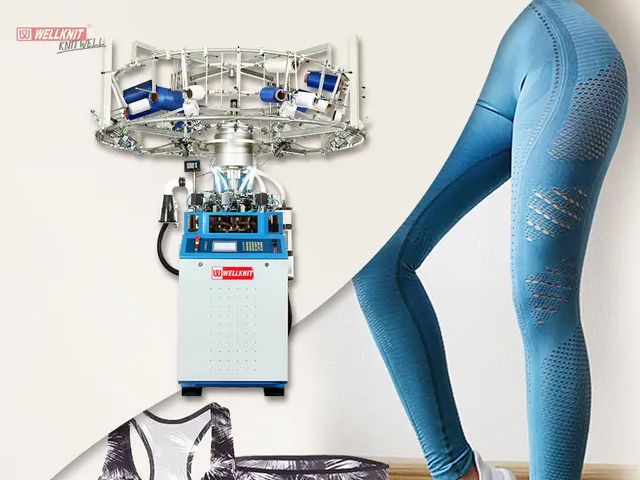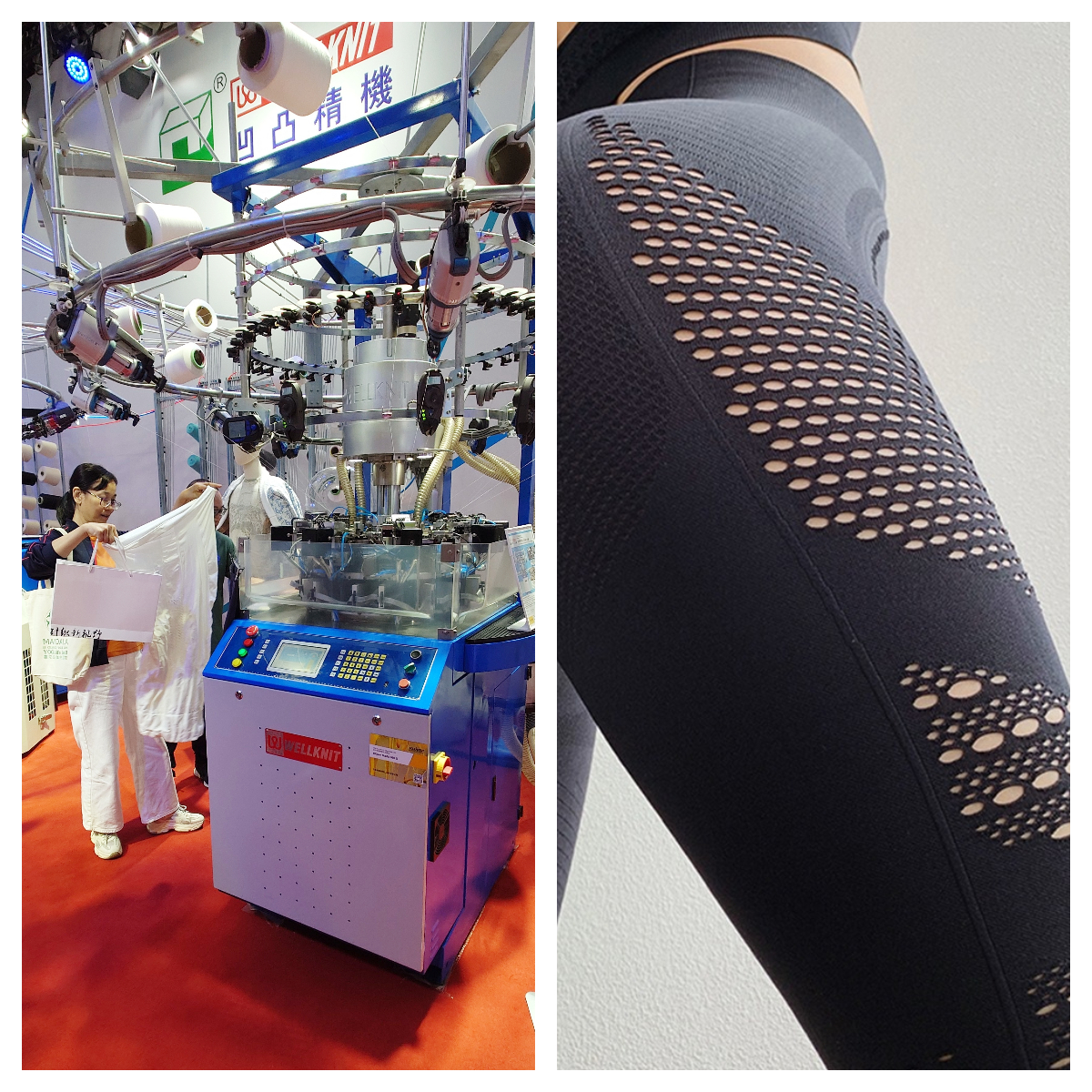- All
- Product Name
- Product Keyword
- Product Model
- Product Summary
- Product Description
- Multi Field Search
Views: 6 Author: Site Editor Publish Time: 2025-09-29 Origin: Site









In today's fast-paced apparel market, underwear brands must balance efficiency, flexibility, and sustainability. Traditional cut-and-sew manufacturing often forces companies into large production runs to amortize setup costs—a strategy that can leave warehouses overflowing with unsold inventory when trends shift or demand falls short. Enter seamless knitting machines and smart production: technologies that are redefining efficiency, slashing overproduction, and enabling truly demand-driven manufacturing in intimate apparel.
Wellknit Textile Technology Co., Ltd., a pioneer in seamless knitting solutions, offers advanced machinery designed for rapid changeovers, small-batch flexibility, and digital control. By integrating these technologies, brands can dramatically reduce fabric waste, avoid costly markdowns, and respond to customer needs in real time.
Most underwear factories still rely on cut-and-sew lines: fabric is cut into panels, sewn together, then finished with elastics, labels, and stitching. Before running the machines, manufacturers must:
Create cutting patterns and sample garments
Set up cutting dies and sewing stations
Order and stock large volumes of fabric and trim
These upfront costs and setup times incentivize large production runs—often thousands of pieces per style and size. The downside? If consumer preferences change, or if a new marketing campaign underperforms, brands are left with significant deadstock. According to industry reports, up to 30% of garments manufactured globally never sell at full price, ending up marked down, donated, or discarded.
Overproduction not only drains company profit margins through markdowns and storage costs, but also contributes to massive textile waste. When inventory goes unsold, the environmental footprint of water, dyes, energy, and labor invested in each item is effectively wasted. In a world increasingly concerned with sustainability, brands that cling to traditional mass-production risk reputational damage alongside financial loss.

Smart production combines digital design, data analytics, and flexible machinery to enable on-demand manufacturing. Rather than predicting demand months in advance, brands can:
Design digitally using 3D models and virtual samples
Analyze sales data in real time to identify fast-selling styles and emerging trends
Program machines remotely to switch patterns, sizes, and colorways instantly
Produce small batches of best-selling items, replenishing stock quickly as orders come in
This approach drastically reduces the need for large safety stocks, slashes lead times, and aligns production volume with actual market demand.
Lower inventory risk: Fewer unsold units and markdowns
Reduced capital tied up: Less money spent on raw materials and warehousing
Faster trend response: Bring new styles to market in weeks instead of months
Improved sustainability: Less waste and better resource utilization
In the digital age, social media, influencer collaborations, and online shopping data create a constant flow of market intelligence. Brands that can act on these insights quickly gain a competitive edge. For example:
A celebrity endorsement spikes demand for seamless boyshorts in pastel hues
A viral fitness instructor recommends a high-waist seamless brief
Seasonal shifts drive interest in lightweight, breathable fabrics
With traditional methods, responding to these spikes would require ordering new fabric, cutting patterns, and setting up sewing lines—a process that can take 8 to 12 weeks. By then, the trend may have passed.
Wellknit's seamless knitting machines are digitally programmed. Using design files (often in CAD formats), operators can:
Upload a new garment pattern to the machine's control panel
Adjust stitch density, yarn tension, and color sequences
Begin production within hours, not weeks
This speed-to-market capability ensures that brands never miss a trend window and can maintain lean inventories that align with real-time consumer demand.
The rise of DTC underwear brands has heightened consumer expectations for unique designs and limited-edition drops. Rather than producing thousands of identical pieces, these brands often release collections in runs of 100–500 units. Seamless knitting machines excel in this environment:
No tooling changes or die setups are needed between runs
Digital recipes store every design variant for instant recall
Versatile yarn feeders allow quick color or material swaps
For brick-and-mortar retailers and e-commerce brands alike, seamless machines empower a just-in-time manufacturing model. Small orders can be fulfilled directly to the distribution center or shipped to consumers, reducing the need for large warehousing footprints. This flexibility supports:
Regional production hubs near key markets
On-demand restocking of best-selling styles
Seasonal or event-based capsule collections
Wellknit's seamless machines integrate PLC (Programmable Logic Controllers) and HMI (Human-Machine Interface) panels that let operators:
Select from a library of saved garment programs
Fine-tune parameters such as knit structure, length, and elastic tension
Monitor production metrics—speed, yarn usage, stitch count—in real time
This level of control eliminates manual intervention between orders and minimizes downtime.
In traditional factories, setting up a new style generates sample waste:
Sample cut-and-sew prototypes
Test runs to adjust sewing tolerances
Discarded fabric remnants from die changes
With seamless knitting:
No physical samples are needed; digital samples suffice
First-run accuracy is high, so test outputs are production-quality
Yarn capacity sensors ensure minimal overfeeding or breakage
As a result, the factory floor sees almost zero waste during style changeovers.

Traditionally, designers create paper patterns, cut fabric swatches, sew prototypes, and adjust repeatedly—a process that can consume meters of fabric and hours of labor. Wellknit's solution:
Make digital adjustments to stitch density, length, and support zones
Generate a production-ready file for the machine, bypassing physical samples
This approach slashes prototyping waste and accelerates time-to-production.
Manual pattern adjustment often leads to misaligned panels or incorrect seam allowances, necessitating fabric scrapping. Seamless knitting:
Eliminates seams altogether, so there are no matching errors
Programs design changes in software, where rules enforce consistency
Tracks yarn usage accurately, so only the exact amount needed is fed
Seamless knitting machines are compact enough to deploy in regional micro-factories near target markets. This localization:
Shortens shipping distances
Reduces customs and clearance delays
Enhances responsiveness to local trends
Looking ahead, integrating AI-driven demand forecasting with seamless knitting could further:
Automatically trigger small-batch runs as sales thresholds are met
Optimize yarn procurement based on predictive analytics
Minimize human intervention and maximize uptime
Brands that embrace these capabilities will enjoy a truly agile and sustainable production model.
In an era where consumer preferences shift overnight and sustainability is paramount, underwear brands cannot afford the inefficiencies and waste of traditional mass-production. Seamless knitting machines and smart production strategies—exemplified by Wellknit Textile Technology Co., Ltd.—offer the tools needed to produce high-quality, on-demand underwear with minimal waste and maximal responsiveness.
By harnessing rapid machine changeovers, small-batch flexibility, digital control, and data-driven decision-making, brands can:
Eliminate excess inventory and markdowns
Slash fabric and sampling waste
Deliver the exact styles consumers want, when they want them
To discover how Wellknit's seamless knitting solutions can transform your manufacturing footprint and help you achieve a lean, agile, and eco-friendly operation, visit knittingmachine.com.tw. For tailored consultation and machine demos, contact Wellknit directly—your partner in crafting the future of waste-free underwear production.
How Seamless Knitting Enhances Breathability And Fit in Eco-Lingerie
How Seamless Knitting Machines Are Revolutionizing Sports Underwear Production
Reducing Waste in Underwear Manufacturing with Seamless Knitting Solutions
How Wellknit Enhances Comfort And Efficiency in Seamless Lingerie Production
Why The Global Lingerie Market Is Shifting To Seamless Underwear Solutions
What Is The Difference Between Circular Knitting Machine And Flat Knitting Machine?
Innovative Design And Production Techniques for Breathable Fashion Wear